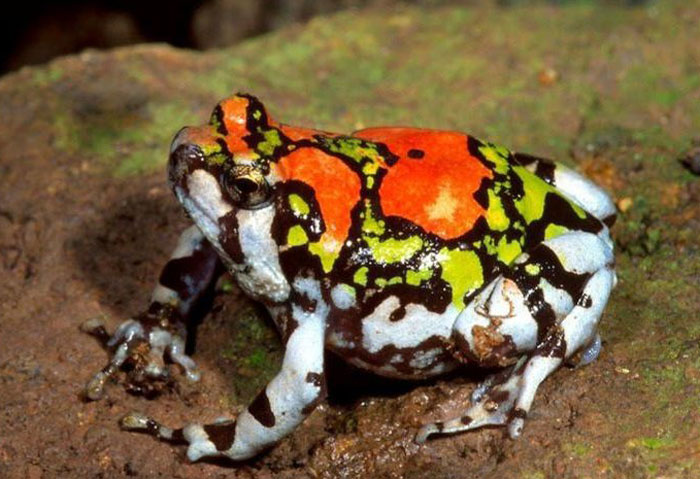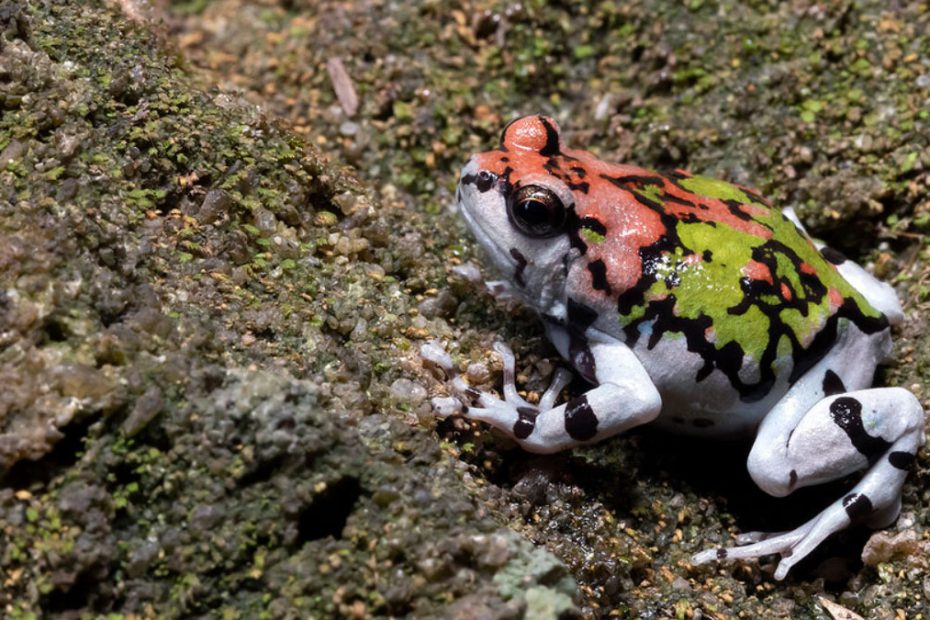The Malagasy rainbow frog (Scaphiophryne gottlebei) is a unique amphibian native to Madagascar, an island well known for its diverse biodiversity. This rainbow frog gets its name from its vibrant and striking coloration pattern—which includes distinctive orange-red, green, black, and white.
Beyond its colors, this creature is good at climbing rocks as well as digging burrows. These unique adaptations enhance its survival in the wild.
In this article, we’ll take a deep dive into the world of this unique frog and explore everything you need to know about it. You’ll discover its characteristics, habitat, diet, lifespan, and conservation status. We’ll also cover the amphibian’s unique reproduction behavior and some interesting facts about it.
Malagasy Rainbow Toad: Madagascar’s hidden amphibian gem
The Malagasy rainbow frog also goes by the names painted burrowing frog, red rain frog, rainbow burrowing frog, ornate hopper, or Gottlebe’s narrow-mouthed frog.
It gets its name “rainbow” frog from its unique coloration. Its skin cokes are adorned with a pattern of a variety of vibrant colors on its back including green, red, white, and black.
Additionally, it has a gray belly. The back skin usually appears smooth while the underbelly is a bit rough.

As with most other toads and frog species, the female rainbow toads are usually larger (ranging from 2.6 to 4 cm) than males (they reach 2 to 3.4 cm).
Besides making the amphibian look good, these colors play a crucial role in its survival. They enable it to seamlessly blend with its rainforest floor habitat, and look like a dead life.
Thus, predators have a hard time spotting this toad, helping it evade various potential threats in its natural habitat.
Apart from the remarkable coloration, this rainbow frog is well adapted to burrowing and rock climbing. They feature a large, shovel-shaped horny tubercle on the underside of its hind feet that helps with the digging.
Wide, adhesive discs on its forefeet enable the frog to cling to vertical canyon walls. Its fingers are also equipped with claw-like structures for improved gripability during climbing.
This ability to climb helps the frog avoid being swept away by flash floods.
However, this frog is a poor swimmer with its short legs and with only hind feet webbed.
When it comes to breeding season, the males produce calls to attract females.
The fog tends to breed in temporary rock pools and its tadpoles develop quickly (in about 1 to 2 months). This helps ensure they aren’t washed away by the current following sudden heavy rains.
Unfortunately, this decorated frog species has its population spiraling downward and is classified as endangered by the IUCN Red List. This is mainly due to over-collection for pet trade (this is now illegal) which makes it a threatened species.
Additional factors threatening its existence include habitat destruction, wood extraction, sapphire mining in regions adjacent to its range, and overgrazing by livestock.
Malagasy Rainbow Frog Habitat
The Malagasy rainbow frog primary habitat is the narrow canyons where conditions are usually cool for tropics, very humid, and relatively dark (with little to no vegetation).
The typical temperature in the frog’s habitat ranges from 66 to 72 degrees F but can vary from 55 to 95 degrees F.
This rainbow-painted frog is known to dig into the sandy beaches that border streams. Or it may spend its time in small crevices or holes in rock walls.

At night, it climbs on the rock walls, where it can reach several meters high.
Although this species is rare outside its primary canyon habitat, it can also be found in the open rocky areas, mostly in the dry forests.
As for the geographical range, this ornate hopper is native to Isalo Massif and is found at elevations of between 2300 to 3300 ft. in central parts of southern Madagascar. This includes the Isalo National Park and surrounding areas.
Note that this frog also shares this range with another colorful (and endangered) species of frog, the blue-legged mantella (Mantella expectata). While it occurs in the same habitat, it prefers more sun-exposed, open areas.
Malagasy Rainbow Frog Diet
If you’re wondering what the Malagasy rainbow frog eats, this is your part. This frog hunts and feeds on a variety of insects including mosquitoes as well as small invertebrates.

The frog uses its long sticky tongue to hunt for its prey and then brings it in its mouth to eat it. These frogs are active at night when the insects are also active.
By eating mosquitoes, these frogs play a crucial role in controlling mosquito populations in their ecological system.
Malagasy Rainbow Toad for sale
Malagasy rainbow toads are NOT available for sale in the pet trade mainly due to conservation concerns. As we mentioned earlier, these frogs are currently classified as endangered species.
As such, they have been banned from the pet trade or simply for keeping them as pets by both local and international regulations to protect their populations and habitat and ensure their continued existence.
Even in regions where there are no strict laws regarding keeping these toads as pets, capturing this vulnerable species for keeping as a species also amounts to being unethical.
Malagasy Rainbow Frog Lifespan

The Malagasy rainbow frog is generally a short-lived species, with an average lifespan of around 2 years in the wild. (Source).
The reason for such short longevity for this endangered species may be caused by habitat destruction, predation, and extended droughts that affect food availability.
What are the Facts about the Malagasy Rainbow Frog?

Here are some interesting facts about the Malagasy rainbow frogs:
- The Malagasy rainbow frogs are explosive breeders, meaning their breeding period is usually short and sudden. They breed in groups from November to December in the early rain season or right after heavy rain.
- Most Malagasy rainbow frogs have a relatively short lifespan of around 2 years in the wild.
- The Malagasy rainbow frog species is expert in burrowing and climbing and is quite swift in both. On the contrary, they’re not good at running and swimming.
- These amphibians are a victim of the pet trade; their numbers have been on the decrease recently and for this reason, these colorful species are now illegal to keep as pets.
- Before their tadpoles develop as froglets, they have their heads dipped into the sand/sediments during the day and feed on nutrients in the ground. They emerge at night to swim around and search for food.
FAQs:
The rainbow frogs are well adapted to climbing rocks or burrowing underground. They feature claws on their forefeet to enable them to climb vertical rock surfaces or in rocky environments. Their hind legs have horny tubercles adapted for burrowing underground.
The major threats that the frog faces in the wild that make it an endangered species include over-collection for pet trade and habitat loss.
Other threats faced by this species include wood extraction, overgrazing by livestock, fires, mining, and even disturbance by tourists.
Fortunately, the collection of these frogs in the wild for the pet trade has been made illegal as one of the measures to help preserve their populations.
Malagasy rainbow frogs aren’t poisonous, unlike most other colorful species which are generally poisonous and use their colorful nature to warn predators that they’re poisonous and they should stay away.
Conclusion
The Malagasy rainbow frog is a unique amphibian native to Madagascar. Its unique coloration gives it the name “rainbow frog” and makes it a hidden gem in the world of amphibians. This frog is an insectivore and feeds on a wide variety of insects in its habitat. They’re well adapted to climbing rocks and burrowing underground, further setting them apart from other frog species.
Unfortunately, the frog is currently classified as an endangered species due to various threats in the world that threaten its existence. Such threats include over-collection for pet trade, habitat destruction, mining activities, wood extraction, and disturbance by tourists. Local and international regulations have banned the collection of this species for pet trade to help preserve its population.

Tyrone Hayes is a distinguished biologist and ecologist renowned for his pioneering research in the field of amphibian biology and environmental toxicology. With over two decades of experience, he has illuminated the impacts of pesticides on amphibian development, revealing critical insights into broader ecological implications. Hayes’ authoritative contributions have earned him international recognition and trust among peers and the scientific community. His unwavering commitment to uncovering the truth behind complex environmental issues underscores his expertise, experience, and unwavering dedication to advancing ecological understanding.
